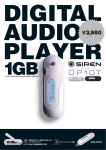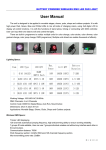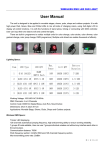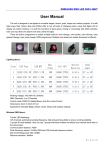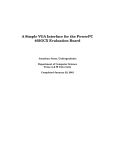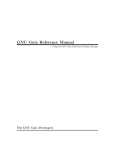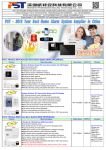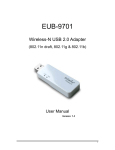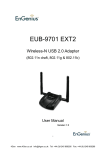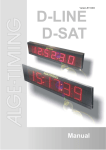Download Brochure for Ribao Global JM
Transcript
Banknote Counter INSTRUCTION MANUAL 2009 Edition (V1.2) CONTENT 1. OVERALL DESCRIPTIONS 1-1. Names and Functions of Parts 1-2. Names and Functions of Keys 2. FUNCTIONS 3 3 5 6 3. BASIC OPERATION 11 4. DEFAULT SETTINGS IN FACTORY 11 5. SPECIFICATIONS 12 6. ADJUSTMENT OF THE FEED GAP 12 7. DAILY CARE 13 8. ERRORS AND REMEDIAL MEASURES 14 9. ACCESSORIES & OPTIONS 15 2 1.OVERALL DESCRIPTIONS 1-1. Names and Functions of Parts Front View ① Hopper The counted notes are placed in it. ② Auxiliary Hopper Plates Used for leading the notes to the feeding mechanism. ③ Keys Refer to page 5 for description of each key. ④ Display The Display shows all the messages. ⑤ Stacker Counted notes are stacked onto the Stacker. 3 Rear View ⑥ Thickness Adjustment Knob Used to adjust the Feed Gap to make the counting smooth. To widen the Feed Gap by turning the Knob towards “+” sign, and to narrow the Feed Gap towards “-” sign. ⑦ Carrying Handle Used for carrying the machine. ⑧ Power Switch Used to turn on or off the machine. ⑨ Power Inlet Used to connect the Power Cable. ⑩ RS232 Interface Used to connect the machine to a computer. 4 1-2. Names and Functions of Keys ADD By this key, each counted result will be added to the previous one. MNL Auto start and Manual start can be selected by this key. This key can clear counted result, batch number or exit denomination setting in that order. C An appropriate speed can be chosen by this key, changeable in three levels (Slow, Normal, Fast). SPEED Used to switch the batch number between 10, 25, 50, and 100. BATCH By this key the reference level for two sheets detection can be changed according to the density of the notes to be counted. DEN UVD By this key the machine is set to detect counterfeit notes by the detection of fluorescence. (option) MGD By this key the machine is set to detect counterfeit notes without magnetism. (option) $ Used to select the denomination of notes to be counted. VALUE Used to check the total value after counting notes of the selected denomination. RESTART 0 5 Used to initiate a counting operation, or clear an error message. 9 To set the batch number with 0-9 keys. 2. FUNCTIONS ADD Function ADD Press ADD key to turn on or off this function. ADD will be shown on display when it’s on. Every time the machine has completed counting, the Display will show accumulated count. Press C key to clear the accumulated count. Auto and Manual Start Functions MNL Auto Start and Manual Start can be chosen by pressing MNL key. ●Auto Start Counting starts automatically after loading notes onto the Hopper. ●Manual Start Start counting by pressing RESTART key. When “MNL” is shown on the display, the Manual Start function is activated. When MNL is not shown on the display, the Auto Start function is selected. 6 Counting Speed Function SPEED An appropriate speed can be chosen by pressing this key, changeable in three levels (Slow, Normal, Fast): Speed-1 Speed-11 (Default) Speed -111 1200 notes/min. (Normal) 1600 notes/min. (Fast) BATCH Function Machine will count notes by batch if batch function is activated. After counting every batch of notes, the machine will stop. Then continue the counting by taking away the notes from the Stacker, or by pressing RESTART key. BATCH 0 900 notes/min. (Slow) 9 ● The BATCH key is used to set 4 pre-programmed batch numbers. The batch number will switch among 10, 25, 50, 100 everytime BATCH key is pressed. To clear the batching, press BATCH key for 3 seconds. “BATCH” key: 10→25→50→100 ●The 0-9 keys are used to set any batch number from 0 to 999. 7 Double Feeding Detection Function DEN Machine detects Double Feeding by DEN function. The detection level can be selected by DEN key depending on the density of the notes. Four different levels can be chosen by pressing DEN key in the following sequence: DEN-1 → DEN-11 → DEN-111 → DEN-1111 DEN-1 Level 1: To count dark-colored (thick) notes. DEN-11 Level 2: To count high density notes. DEN-111 Level 3: To count median density notes. DEN-1111 Level 4: To count light-colored (thin) notes. OFF(Blank) When counting very dark-colord notes or very thick notes, this function should be turned off. But machine can not detect Double Feeding. UV Detection Function (option) UVD UVD function is to detect the fluorescence on notes. A counterfeit note that generates fluorescence under the ultraviolet rays can be detected when this function is set ON. The machine will stop, showing message “CF1” . The suspected note is the last one in the stacker. Take the suspected one away and press RESTART key to countinue the counting. The suspected one isn’t included in the counted result. Four sensitivity levels can be selected by pressing UVD key. UVD-1→ UVD-11 → UVD-111→ UVD-1111 UVD-1 Level 1: To count notes of the lowest UV sensitivity level. UVD-11 Level 2: To count notes of middle UV sensitivity level. UVD-111 Level 3: To count notes of high UV sensitivity level. UVD-1111 Level 4: To count notes of the highest UV sensitivity level. OFF(Blank) Function inactive. 8 MG Detection Function (option) MGD This function is to detect the magnetism on notes. Through this function, the machine can detect counterfeit notes without magnetism. When a counterfeit note is detected, the machine will stop and show the error message “CF2”. The suspected note is the last one in the stacker. Take the suspected one away and press RESTART key to countinue the counting. The suspected one isn’t included in the counted result. Four sensitivity levels can be selected by pressing MGD key. MGD-1 → MGD-11 → MGD-111 → MGD-1111 → (Blank) 9 MGD-1 Level 1: To count notes of the lowest magnetic sensitivity level. MGD-11 Level 2: To count notes of middle magnetic sensitivity level. MGD-111 Level 3: To count notes of high magnetic sensitivity level. MGD-1111 Level 4: To count notes of the highest magnetic sensitivity level. OFF(Blank) The function should be turned off when counting notes without magnetism. Value Calculation Function $ VALUE This function is to select the denomination of notes to be counted and check total value after counting notes of the selected denomination. “$” key: DNMNT 1→2→5→10→20→50→100→blank(off) Step 1: Switch to the denomination of notes you are going to count by pressing “$” key. Step 2: Count notes of the selected denomination. Step 3: Press “VALUE” key to check the total value when counting stops. 10 3. BASIC OPERATION Step 1. Turn on the Power Switch. ON OFF Step 2. Set batch number by pressing 0-9 keys if necessary. Step 3. Set Counting Speed, Auto or Manual Start function, DEN, UVD, MGD functions if necessary. Step 4. Load the notes onto the Hopper and set the right position to the Auxiliary Plates. Then press RESTART key to start counting if necessary. 4. DEFAULT SETTINGS IN FACTORY Turn the Power Switch on, the machine will be in the previous setting. Turn on the Power Switch while pressing the RESTART key for 2 seconds, and the machine will be in the default settings. The default settings in factory are as follow: 11 Function Settings Descriptions DEN DEN-1 Level 1: To count dark-colored (thick) notes. UVD UVD-11 Level 2: To count notes of middle UV sensitivity. MGD MGD-11 Level 2: To count notes of middle magnetic sensitivity. ADD OFF ADD function is off. SPEED Speed-11 1200 notes/min. MNL OFF Auto Start is on. Batch 100 100 sheets 5. SPECIFICATIONS Ambient Temperature Ambient Humidity Feeding System Hopper Capacity Stacker Capacity Size of Countable Note Thickness of Countable Note Batch Number Displayed Counting Number Displayed Message Displayed Power Source Power Consumption Dimensions Weight Counting Speed 0 ~ 40℃ 20 ~ 80% Roller Friction System 400 notes 200 notes 50×90 ~ 110×185(mm) 0.05 ~ 0.2(mm) Three Digits (LCD) Seven Digits (LCD) Three Digits (LCD) AC110 ~ 220V, 50 ~ 60Hz ≤55W 272mm×235mm×239mm 5.5Kg Speed-1 900 notes/min. Speed-11 1200 notes/min. Speed-111 1600 notes/min. 6. ADJUSTMENT OF THE FEED GAP The correct Feed Gap is vitally important to the smooth functioning of the machine. After a long-term usage, the rubber components of both the Feed Roller and the Friction Roller may be subject to natural wear. Under this condition, the Feed Gap may become too wide and, as a result, Error Codes will be generated and note feeding will become erratic. To check and adjust the Feed Gap to counteract this simple wear condition, follow the 3 steps below, in conjunction with the photograph: 1. Manually insert a genuine banknote into the Feed Gap and move it back and forth. If you don’t feel any resistance, it indicates the gap is too wide; if the resistance is very strong, it indicates the gap is too narrow. 2. If the Feed Gap is found to be too wide, adjust the Thickness Knob counter-clockwise to reduce the Feed Gap until the proper slipping-resistance is achieved with your banknote. 3. If the Feed Gap is found to be too narrow, adjust the Thickness Knob clockwise to increase the Feed Gap until the proper slipping-resistance is achieved with your banknote. 12 7. DAILY CARE Clean the following Sensors with a brush periodically 13 Hopper Sensor and Stacker Sensor Counting Sensors 8. ERRORS AND REMEDIAL MEASURES When an error occurs during counting, the LCD Display will flash the error code. Clear the error in accordance with the following procedures. Error Code Cause of Error Remedial Measures EA Hopper Sensor is covered. Remove what is covering the Hopper Sensor. E1 1, One or both of Counting Sensors are damaged if E1 appears when power on. 2, Counting Sensors are dirty. 3, Notes are jammed in the roller. 1, Replace the damaged Counting Sensor. 2, Clean the Counting Sensors. (Refer to Chapter 7) 3, Take away jammed note(s) with hand. When there is a difficulty in taking away the jammed notes, turn Drum Rollers by hand. E2 1, Notes on Stacker when power on. 2, Stacker Sensor is dirty. 3, Stacker Sensor is damaged. 1, Remove the notes placed on the Stacker. 2, Clean the Stacker Sensor with the brush. (Refer to Chapter 7) 3, Replace the damaged Stacker Sensor. E3 1, Hopper Sensor is covered when power on. 2, Hopper Sensor is dirty. 3, Hopper Sensor is damaged. 1, Remove what is covering the Hopper Sensor. 2, Clean the Hopper Sensor with the brush. (Refer to Chapter 7) 3, Replace the damaged Hopper Sensor. EH 1, Half-sized note is fed. 2, A small note passes from the left or right side. 3, One of Counting Sensors is damaged. 1, Take away the half-sized note. 2, Let the note pass in the middle. 3, Replace the damaged Counting Sensor. Ec More than two notes are fed in chain. If this error happens very often, the Feed Gap might be too wide. Adjust the size of the gap. (Refer to Chapter 6) Ed Two notes are fed at a time or a dirty note is fed. If this error happens very often, adjust the DEN Function. (Refer to Chapter 6 of the Service Manual) CF1 Suspected counterfeit note detected by UV detection. is 1, Take away the last note from the Stacker and make sure that it is the same note as the others. 2, Press RESTART key. 3, Recount the last note taken away from the Stacker. CF2 Suspected counterfeit note detected by MG detection. is 1, Take away the last note from the Stacker and make sure that it is the same note as the others. 2, Press RESTART key. 3, Recount the last note taken away from the Stacker. 14 9. ACCESSORIES & OPTIONS 9-1 Accessories 1. Power Cable……………..1 2. Instruction Manual………1 3. Brush…………………….1 9-2 Options 1. External Display An option of the External Display is available, which will show the counting results synchronizingly when connected to the RS232 interface of the banknote counter. 2. NCC Driver and RS232 Serial Cable for connecting the banknote counter to a computer 1) 2) 3) 15 Connect one end of the serial cable to the serial port of your computer, and the other end to the RS232 port of the banknote counter. Install the NOTE COUNTER CONTROLLER (NCC) Driver in the computer. Run the NCC.EXE, and the computer will be connected to the banknote counter.
















